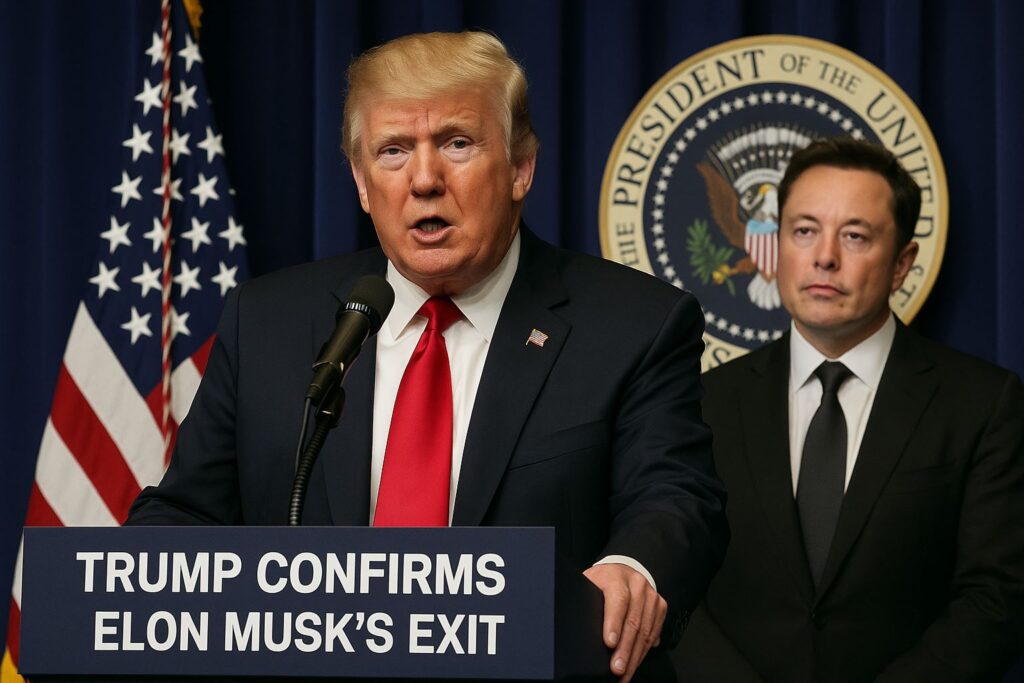Trump Confirms Elon Musk’s Exit: In a move that’s sending shockwaves through Washington and Silicon Valley alike, President Donald Trump confirmed Elon Musk’s exit from his Cabinet at a special press conference. Musk, who served as the head of the Department of Government Efficiency (DOGE), is stepping down just 130 days after his controversial appointment — and the political, economic, and cultural ripples are already in motion.
This sudden departure has ignited debates about the role of billionaires in public service, the feasibility of running the federal government like a tech startup, and what Musk’s exit means for the future of Trump’s administration — and America.
Trump Confirms Elon Musk’s Exit

| Topic | Details |
|---|---|
| Position | Head of the Department of Government Efficiency (DOGE) |
| Tenure | 130 days (January – May 2025) |
| Savings Claimed | $175 billion (Washington Post) |
| Original Goal | $2 trillion in budget cuts |
| Agencies Dismantled | USAID, Consumer Financial Protection Bureau |
| Reason for Exit | Disagreements over tax/spending bill |
| Trump’s Response | Praised Musk, gave symbolic “key to the White House” |
| Musk’s Future Role | Unofficial advisor to the administration |
| Official Source | White House Website |
What Is the Department of Government Efficiency (DOGE)?
The Department of Government Efficiency (DOGE) was created in early 2025 by President Trump as a new executive body tasked with trimming bureaucratic waste, cutting redundant programs, and optimizing federal operations.
Trump’s decision to appoint Elon Musk — founder of Tesla, SpaceX, and X (formerly Twitter) — was seen as bold, if not controversial. Musk’s mission: slash $2 trillion from the federal budget using his trademark no-nonsense, engineering-first mindset.
This department was never confirmed by Congress in the traditional sense. Instead, it operated under executive authority, drawing fire from both legal scholars and members of Congress who questioned its legitimacy and oversight.
What Did Elon Musk Actually Do?
While Musk’s $2 trillion savings target grabbed headlines, the real outcome fell short — with his office claiming $175 billion in cuts, much of which came from layoffs and contract cancellations. Here’s what he actually implemented:
Eliminated Entire Federal Agencies
- USAID and the Consumer Financial Protection Bureau (CFPB) were effectively dismantled.
- Musk called these agencies “outdated and overfunded,” though critics warned this leaves gaps in international aid and consumer rights.
Cut Thousands of Federal Jobs
- Over 30,000 federal workers were laid off, according to early reports.
- While Musk defended the move as eliminating “redundant positions,” federal unions filed multiple legal complaints.
Federal Contract Revisions
- Musk audited more than 5,000 contracts, terminating nearly 600.
- Contracts with outdated vendors, especially in IT, were the main targets.
Reactions to the Results
Watchdog groups and bipartisan members of Congress disputed the savings, claiming many of them were “projected” or “theoretical” rather than actualized.
“We applaud innovation, but not lawlessness,” said Rep. Adam Schiff (D-CA).
“Elon shook the tree. We needed that. But pruning and burning are two different things,” said Sen. Josh Hawley (R-MO).
Why Did Elon Musk Leave the Cabinet?
The final nail came when Congress passed a massive tax-and-spending bill, which Musk opposed. He argued that the bill ballooned the federal deficit and contradicted DOGE’s purpose.
Despite his opposition, the bill passed with bipartisan support — reportedly infuriating Musk, who felt sidelined by the political establishment.
At a press conference, Trump tried to smooth things over:
“Elon is a genius. We don’t always agree, but he did tremendous work. He’s not really leaving — he’s always welcome in the White House.”
Musk, for his part, posted on X:
“The mission is complete — for now. The system resists change. But we’ll keep pushing, from the outside.”
What Happens to DOGE Now?
Though Musk is out, DOGE is not being dismantled. Trump stated the department will continue under the guidance of his Cabinet members, with a possible new head announced in the coming weeks.
Who Might Replace Musk?
Speculation points to:
- Larry Kudlow, former Trump economic advisor
- Carly Fiorina, former HP CEO
- A potential military leader with logistical experience
What Should Professionals Know?
For those in government, contracting, or nonprofits:
- Review contracts affected by DOGE audits
- Prepare for leadership changes in federal procurement and compliance
- Track Musk’s influence as an informal advisor

How Does Trump Confirms Elon Musk’s Exit Affect the Upcoming Elections?
Musk’s departure adds fuel to both pro- and anti-Trump narratives heading into 2024 midterms and 2028 primaries. It highlights tensions between populism and technocracy, as well as Trump’s ongoing push to disrupt federal norms.
Polling from Gallup shows:
- 43% of Americans approved of Musk’s reforms
- 52% disapproved of his tactics
- 68% agree “government spending is too high”
This suggests Musk’s presence — even outside the Cabinet — could still be a wild card in American politics.

What’s Next for Elon Musk?
Musk is expected to refocus on:
- Tesla, especially with new AI-powered vehicles in 2026
- SpaceX’s Mars program
- Neuralink and xAI development
- And, of course, X (Twitter) as a platform for political engagement
Some insiders believe Musk may play kingmaker in the next election, supporting candidates or policies aligned with his vision.
Legal and Ethical Fallout
Musk’s time in DOGE hasn’t ended quietly. Legal groups have filed Freedom of Information Act (FOIA) requests demanding records of:
- Layoff criteria
- Internal communications
- Closed-door advisory meetings
Ethics experts have raised concerns about conflicts of interest, given Musk’s overlapping roles in defense contracts (via SpaceX) and federal tech reviews.
Trump’s Emergency Tariff Tactic Backfires; Could It Collapse His Trade War Strategy?
Elon Musk Becomes Kekius Maximus Again – Check How Crypto Surged!
Why House Republicans Are Quietly Nervous About Trump’s ‘Big Beautiful Bill’











